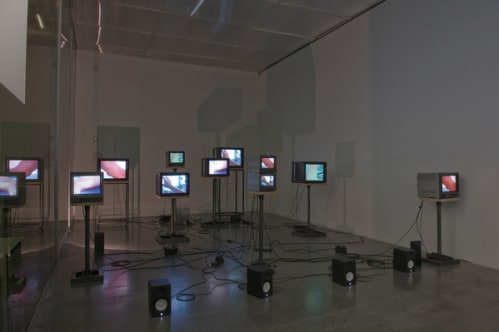Charles Atlas Joints 4tet for Ensemble, 1971/2010 Super 8mm film transferred to video, 4 channel video, colour. 4 channel sound using material recorded by John Cage, 10 Sony monitors, 10 metal stands, 2 programmed projection lights and 4 flash players, 10 studio monitors This installation consists of a series of short super-8 colour films made by Charles Atlas and Merce Cunningham in 1971 and shown for the first time by Charles Atlas in 2010 in four channels of synchronized video across a choreographed arrangement of 10 different sized monitors. The monitors are arranged in a variety of ways: as single monitors of varying sizes on mono-stands, rolling carts, and as pairs of smaller monitors. The configuration of the installation harks back to ideas Atlas used in the creation of “Fractions”, a video/dance collaboration he made together with Cunningham in 1978. The sound consists of four unpublished selected ambient recordings made by John Cage in the 1980s of the sound in various cities around the world where he and his long-term partner Merce Cunningham had been to together. As the films play out across the monitors, projection lamps cast multiple and shifting shadows over the surrounding walls of the installation. One afternoon in 1971, after rehearsal in Irvine, California, Merce Cunningham and Charles Atlas went out of the back door of the dance studio to a raised concrete dock and Atlas shot close-ups of Cunningham's wrist, elbow, ankle, and knee. Atlas cannot recall entirely all the circumstances surrounding the filming, but we do know that the film was purely experimental. Cunningham articulated his joints in a kind of minimal dance and Atlas filmed in a variety of ways with his new super-8 camera. Atlas made nine short films in total, which were mainly extended continuous hand-held shots. The films capture Cunninham's unique style of movement. Atlas experimented with different frame rates and levels of blur, but mainly focused on following Cunningham’s moving joints as if observing a strange animal. The material was not shown at the time because Atlas considered it a sketch. However in revisiting the material it is clear to see that the films retain a freshness, casualness, intimacy, and lack of pretension that sets them apart from other later and more formal collaborations between the two artists. Video art, with its emphasis on mirroring the movements of the subject via direct re-projection, has oft been linked with an inherent type of narcissism. But what happens when the subject is scattered? The body here is fragmented and scaled up. Rather than the production of self-enclosure here we have a spreading out, as individual parts of the body cannot be assimilated into a totalized whole. Each monitor presents a singularized part abstracted and transformed. And reflecting Atlas’s ongoing interest in tracking the simple movement of dancers in and around a studio, each monitor is orchestrated to broadcast the observation of an autonomous trail within the overall choreography of the group. The theme of mirroring of the subject in now canonised works by Bruce Nauman et al has been linked to the advent of the cari-cam and its instant-playback function. In terms of Atlas’s relation to this theme of the real time re-production and direct mirroring of the self, it is interesting to note that though contemporaneous with this era, Atlas’ film was actually shot on 16mm film (the footage was transferred to video only in 2010), and so forwent this element of directness. Re-looking at trails of collaborations in the past:- Cunningham and Atlas’s in the original material shot, and Cage’s and Cunningham’s in the recordings, Atlas’s present installation is invested with love for his good friends. But though their physical presence is now a relic, recorded and immortalised on tape, in memory it casts its multiple shadows to inform the formations of these new configurations as they move into the future in fidelity to them.

